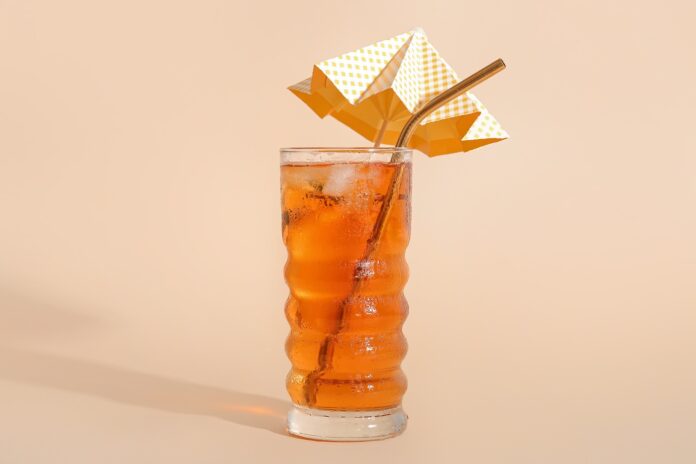
No matter how you pour it, beverage revenue across alcoholic drinks, non-alcoholic drinks, hot drinks, and cannabis-infused drinks has been growing each year since 2020. But no drink category comes close to the opportunity presented by the cannabis-infused segment, with an estimated compound annual growth rate of approximately 50 percent over the next five years.
Industry brands like Tilray are betting big on the adult beverage category with a recent $85-million Anheuser-Busch deal that triples its beverage portfolio through the acquisition of eight new brands—a massive distribution advantage should federal legalization take hold. But according to data from cannabis analytics firm BDSA, it’s brands like Uncle Arnie’s, Levia, and Keef Cola that have been the most popular infused drink options for American palates and wallets.
BDSA’s recent market research on the opportunities in the cannabis beverage market provides an informative look into the growth of the segment, going beyond the overly simplistic view of cannabis-infused beverages as a singular product. The data focuses on specific products consumers have purchased as well as the different types of beverages being sold including sodas, powdered drink mixes, and ingredients for cannabis mocktails that serve as a replacement for alcohol.
“Looking at the total beverage category, [ready-made] drinks made up 74 percent of dollar sales, followed by powdered mix products,” said Brendan Mitchel-Chesebro, marketing content manager at BDSA. “‘Other beverages’ is the segment after that with 8 percent of sales. The biggest percentage [of that category] is cocktail mixers for making mocktails that are THC-infused.”
According to the most recent data on American drinking preferences from Gallup, the popularity of beer among U.S. drinkers has been on the decline since 2016, with 35 percent of drinkers naming beer as their preferred alcoholic beverage. While consumers in established markets have no shortage of infusion options, carbonated ready-made drinks that can substitute for beer remain the single most popular format.
“Fifty-eight percent of drink sales in Q2 2023 are carbonated drinks, compared to 42 percent that are non-carbonated,” he said.
Brands enjoying success
While the report highlights the success of specific brands selling well this summer, Mitchel-Chesebro was quick to point out how the biggest markets like California and Colorado are the ones driving and potentially skewing the sales figures.
“Uncle Arnie’s is a brand that’s done really well,” he said. “They’ve been successful in a few ways. They’ve been around since the early days of adult-use sales in California, and just this past year, they’ve seen this huge sales growth.”
According to Mitchel-Chesebro, distribution and brand recognition are a large part of Arnie’s success. It’s why he thinks the company has been able to earn the top-selling product in the beverage category for Q2 2023 with its iced tea lemonade.
“The second best is the Dream Seltzer from Levia, and the third best seller is Bubba Kush Root Beer from Keef Cola. Those are the top brands across all the markets that we track,” said Mitchel-Chesebro. BDSA’s report references retail sales data from 14 states.
Uncle Arnie’s is hardly shy when it comes to sharing its expansion plans. The company’s goals include growing market share in California beyond the 40 percent of stores already carrying its products in the state. The brand expanded into Oregon last year and Nevada this summer with plans to launch in Michigan soon.
“We’ve chosen very familiar flavors across the board,” said Uncle Arnie’s chief executive officer Theo Terris. “We looked at convenience store data and focused on juices and lemonades.”
Terris added that he’s confident expansion in the beverage category will continue as the market grows.
“When Uncle Arnie’s started a little bit more than three years ago, the beverage category in California was anywhere between a quarter or half a percent of the overall market,” he said. I was looking on Headset this morning and over the last 30 days, that number has grown to almost four percent.”
Terris recognizes that it’s still a small category, but the growth is clearly there. He believes in the next two or three years the numbers will continue at a strong pace, growing into a significant part of the larger cannabis marketplace in the not-too-distant future.
“My guess is [beverages eventually reach] somewhere between 10 to 25 percent of the overall market.”
Libation innovation
Terris pointed out that the beverages category will likely see innovation as well in the coming years.
“There’s always going to be a winner in that juices and soda space, but seltzers I think are going to be a big category,” he said. “I think there will also be a lot more technology with the actual drinks themselves, in terms of onset time and offset time.
These include low-dose options like Cann Beverages’ Social Tonics, flavorless enhancers that can infuse any beverage, and infused drinks that replace alcohol with THC and CBD. Beverages also have the advantage of being able to capitalize on nano-emulsification technology, which allows for quicker on-set times.
It’s clear that beverages have only become more popular as the industry has spread its wings to new territories. With greater access, ongoing competition for market share, and an inviting option for social situations, it’s safe to assume drinks will continue their popularity among cannabis consumers.